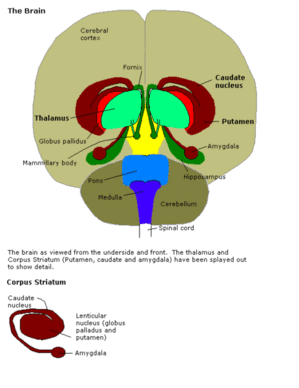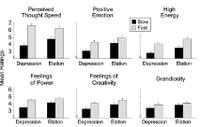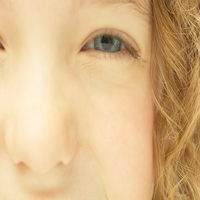Sleep Deprivation and Emotional Instability

Most of the time we are in control of our moods, rather than our moods being in control of us. One of the main things that we learn as we get older is not simply to damp down our emotional reactions, but to make them “contextually relevant:” we produce the right emotional response for the right situation. Yet we also know that there are exceptions: times when our emotions over-run any attempts at our control.
Second, we all know that sleep deprivation can be a Bad Thing. It is known to impair a range of mental and physical activities, including immune function, metabolic control and many cognitive processes, including learning and memory.
It has long been suspected that sleep deprivation can have significant effect on mood. Many of us feel irritable and distractible if we haven’t slept enough, and you may have had the experience of being up all night and feeling a little bit “high” in the morning. It has also been known for centuries that mood disorders are very commonly associated with sleep disturbances, and sleep disturbance is often the first sign that someone with mood problems is running into trouble. So mood and sleep must be linked in some way.
Despite these common observations, there has never been that much empirical evidence for the impact of sleep deprivation on mood, and in particular the effects of sleep deprivation on the brain.
An important new study by researchers from Harvard Medical School and the University of California at Berkeley has just been published in the journal Current Biology, and it is beginning to fill in some of the gaps in our knowledge.
The amygdala is known to be involved in processing of emotionally salient information, particularly unpleasant or aversive stimuli. In mature individuals, the emotional centers of the brain are usually controlled and modulated by an array of connected systems, mainly in the frontal regions of the brain. One particularly important part of the frontal lobes that is involved in controlling the amygdala is the medial-prefrontal cortex (MPFC). Under normal conditions the MPFC is supposed to exert an inhibitory, top-down control of the amygdala, so that we only generate appropriate emotional responses.

The scientists worked with 35 volunteers who were deprived of sleep for 35 hours. Blood flow can be used to deduce which specific regions of the brain are active. The researchers used functional magnetic resonance imaging (fMRI) to examine the blood flow – and therefore activity – in the brains of the volunteers in real time, both during and after sleep deprivation.
After going without sleep, the participants were asked to look at images that were designed to trigger angry or sad emotional responses. The investigators discovered that the amygdala showed 60% higher reactions to the images compared with people who are not sleep-deprived.
This is an extraordinarily large effect and implies that sleep deprivation knocks out the normal control mechanisms in the frontal lobes so that the sleep-deprived brain reverts to a more primitive pattern of activity. As a result we become unable to put emotional experiences into context and produce controlled, appropriate responses.
If we needed any more reasons to get a good night’s sleep, this one is very powerful. It also re-iterates something very important: if you or a loved one have had problems with mood, anger or anxiety, it is essential to watch your sleep pattern. Any change may be a harbinger or trouble, and is an excellent early warning that you or they need a hand to make sure that things stay on an even keel.
“Your brain shall be your servant instead of your master, you will rule it instead of allowing it to rule you.”
–Charles E. Popplestone (American Author of Every Man a Winner, 1936)
“Control your emotions or they will control you”
–Chinese Proverb
“For the uncontrolled there is no wisdom, nor for the uncontrolled is there the power of concentration; and for him without concentration there is no peace. And for the unpeaceful, how can there be happiness?”
–Bhagavad Gita (Ancient and Sacred Sanskrit Poem Incorporated into the Mahabharata)
“He who controls others may be powerful, but he who has mastered himself is mightier still.”
–Lao Tzu (Obscure Chinese Philosopher, Founder of Taoism and Alleged Author of the Tao-Te Ching, c. 604-c. 531 B.C.E.)
“ . . . let every man be swift to hear, slow to speak, slow to wrath.”
–The Bible, James 1:19
“When angry, count ten before you speak; if very angry, a hundred.”
–Thomas Jefferson (American Writer, Philosopher, Politician and, from 1801-1809, 3rd President of the United States, 1743-1826)
Larks, Owls and Depression

It is well known that mood disorders are associated with the disruption of many of the circadian rhythms of the body including sleep, temperature and thyroid function. These links are so well known that many experts believe that depression may be a consequence of disturbances in circadian rhythms.
Although circadian rhythms tend to be fairly consistent across individuals, but there are significant differences in these rhythms in different people: we call this the “morningness-eveningness” dimension (MED).
As part of a larger project, researchers from Providence, Rhode Island last month presented a most interesting study (NR293) at the 2007 Annual Meeting of the American Psychiatric Association in San Diego.
People with psychiatric problems tend to be owls: evening types who don’t like mornings, and this was particularly striking in people with depression.
This suggests that “eveningness” may be reflecting a risk factor or vulnerability to psychopathology, in particular depression. It may actually be that if you are a “morning person,” you may have some protection against developing depression.
I remember seeing a study from Stanford in April that suggested that people labeled a “night owls” report more pathological symptoms related to insomnia, despite many having the opportunity to compensate for their nocturnal sleeplessness by extending their time in bed and being able to gain more total sleep time. So this may be the link with depression.
Teenage Mood Swings

How many of us have been perplexed by the violent mood swings of teenagers? One minute they are out skipping through the countryside and picking wild flowers. The next they seem intent on burning down the forest…
The mood swings and anxiety often make them seem as if they have some kind of “bipolar-lite.”
An important new study has revealed that teenage mood swings may be explained by biological changes in the adolescent brain. The research is published in the journal Nature Neuroscience.
Sheryl Smith, a physiologist at the State University of New York, and her colleagues experimented on adolescent female mice and showed that their brains respond to stress in a different way from adults and pre-pubescent individuals.
Anxiety is highly complex and involves a cascade of chemical neurotransmitters and genes. One of its important regulators is the brain’s principal inhibitory neurotransmitter, gamma-aminobutyric acid (GABA). GABA counteracts the effect of glutamate, an excitatory neurotransmitter in the limbic system of the brain. There is a kind of Yin/Yang relationship between GABA and glutamate.

The brain is full of what are known as “Neurosteroids:” steroid molecules that interact with genes and receptors in nerve cells. Neurosteroids generally reduce anxiety, but this research shows that they promote anxiety in female mice around puberty via the selective desensitization of extrasynaptic GABA-A receptors.
Stress causes the release of a steroid known as 3α,5α-Tetrahydroprogesterone also known as Allopregnanolone or THP. In adult and pre-pubescent individuals THP increases the “calming” effect of GABA in the limbic system. However, Smith and her team found that THP had the opposite effect in adolescent mice. In other words the developing adolescent brain simply behaves differently
It would appear that THP has two roles, one in the limbic system where it helps to calm things down, and another in the hippocampus where in adolescents it heats things up. The hippocampus is important in memory and also in the regulation of emotion.
The underlying mechanism appears to be different levels of expression of a type of receptor known as the “alpha-4-beta-2-delta” GABA-A receptor in the hippocampal brain region known as CA1.
In adults and pre-adolescents there are few of these receptors and THP modulates and calms these regions of the brain.
However, in adolescents, the expression of these receptors is high, and the anxiety raising effect of THP in the hippocampus outweighs the calming effect it has in the limbic system.
Smith and her team were able to reverse the puberty effect in the mice by genetically altering the number of receptors.
The result of all this is that the teenage brain amplifies its reactions to stress. So whether the young person reacts by crying or being angry, the emotion will be much more pronounced than it would be in a pre-pubescent person or an adult. To adults it may seem like an overreaction, to the teenager it is his or her only response.
This study is thought to be the first to suggest an underlying physiological, as opposed to a psychological explanation for teenage mood swings.
Apart from raising understanding about what teenagers are going through, the finding raises the possibility of a new approach to more severe mood swings, such as bipolar disorder.
Psychological Problems, Stigma and Success

I do a lot of work to try and de-stigmatize mental illness, and to emphasize that all of my experience and all the scientific evidence makes it very clear that most psychological and psychiatric problems lie on a spectrum. We define something as an “illness” only if it is causing suffering or distress.
Because of my work I know about the physical and psychological problems of a great many people in the public eye, but I will obviously not talk about people unless they decide to say something themselves.
When I am speaking to politicians or the media I often show them a list of some of the people with psychological problems who have gone public.
I just found this long list of Deborah Serani’s blog. There were a number of names of people whom I did not know had revealed that they had suffered from problems. I am pleased that Deborah offered some references. I have also added a few names from my own research.
If there are any mistakes, please let me know and I shall correct them.
I would like to make three points:
- Psychological problems and psychiatric illnesses are common and usually treatable
- Having been diagnosed with one of these problems does not preclude you from outstanding success
- This list does not include people with substance abuse problems, though these problems are usually as physical as any other
I do hope that you will find it helpful to see just how many terrific people have had their downs as well as their ups!
John Quincy Adams (US President)
Alvin Ailey (Choreographer)
Lionel Aldridge (Football Star)
Buzz Aldrin (Astronaut)
Adam Ant A.K.A. Stuart Goddard (Singer)
Ann-Margaret (Actor)
Louie Anderson (Comedian Actor)
Gillian Anderson (Actress)
Fiona Apple (Musician)
Diane Arbus (Photographer)
Isaac Asimov (Author)
Drew Barrymore (Actor/Producer)
Daniel Boorstin (Former Us Presidential Adviser)
Zach Braff (Actor)
Art Buchwald (Columnist)
Oksana Baiul (Skating Star)
Kim Basinger (Actress)
Ned Beatty (Actor)
Syd Barrett (Musician)
Ludwig Van Beethoven (Composer)
Maurice Bernard (Actor)
Irving Berlin (Composer)
Danny Bonaduce (Actor/Radio DJ)
Halle Berry (Actor)
Kjell Magne Bondevik (Prime Minister of Norway)
Steve Blass (Baseball Star)
Charles “Buddy” Bolden (Musician)
Robert Borrstin (Political Advisor)
David Bowie (Singer)
Marlon Brando (Actor)
Jeremy Brett (Actor)
Charlotte Bronte (Author)
Robert Burns (Poet)
Willie Burton (Athlete)
Barbara Bush (Former First Lady – U.S.)
Delta Burke (Actor)
Carol Burnett (Actress/Comedian)
Lord Byron (Poet)
Cher (Singer/Actress)
Dick Clark (Producer/Music Magnate)
John Candy (Comedian)
Ray Charles (Musician)
Deanna Carter (Singer)
Helen Caldicott (Activist/Writer)
Dean Cain (Actor)
Drew Carey (Actor/ Comedian)
Earl Campbell (Football Star)
Eric Clapton (Musician)
Jim Carrey (Actor/Comedian)
Melanie Chisholm (Singer)
Naomi Campbell (Model)
Rosemary Clooney(Singer)
Jose Canseco (Baseball Star)
Shawn Colvin (Musician)
Mary Jo Codey (First Lady Of New Jersey)
Judy Collins (Musician)
Dick Cavett (TV Host/Writer)
Courtney Cox (Actor)
Margaret Cho (Actor/Comedian)
Natalie Cole (Singer)
Michael Crichton (Writer)
Francis Ford Coppola (Director)
Sheryl Crow (Musician)
Winston Churchill (English Prime Minister)
Nicolas Cage (Actor)
Sandra Cisneros (Writer)
Patricia Cornwell (Writer)
John Cleese (Comedian/Actor)
Leonard Cohen (Musician)
Paula Cole (Actor)
Shayne Corson (Hockey Star)
Judy Collins (Musician)
Shawn Colvin (Musician)
Jeff Conaway (Actor)
Ty Cobb (Baseball Star)
Pat Conroy (Writer)
Billy Corgan (Musician)
Calvin Coolidge (US President)
Bill Dana (Comedian)
John Daly (Golf Star)
Rodney Dangerfield (Comedian/ Actor)
Charles Darwin (Scientist)
Jefferson Davis (President Of The Confederate States Of America)
Jonathan Davis (Musician)
Sandra Dee (Actor)
Gaetano Donizetti (Opera Singer)
Mike Douglas (TV Host)
Walt Disney (Entrepreneur)
John Denver (Musician)
Dame Edna Everage a.k.a. Barry Humphries (Comedian)
Ellen Degeneres (Comedian/Actor)
Richard Dreyfuss (Actor)
Johnny Depp (Actor)
Paolo Dicanio (Soccer Star)
Eric Douglas (Actor)
Charles Dickens (Author)
Patty Duke (Actress)
Scott Donie (Olympic Star)
Kitty Dukakis (Former First Lady Of Massachusetts)
Michael English (Singer)
Jim Eisenreich (Baseball Star)
Thomas Edison (Inventor)
Ralph Waldo Emerson (Writer)
Robert Evans (Film Producer)
Jules Feiffer (Cartoonist)
James Farmer (Civil Rights Leader)
Edie Falco (Actress)
Betty Ford (Former US First Lady)
Carrie Fisher (Actress)
James Forrestal (Undersecretary Of US)
Eddie Fisher (Singer)
Aretha Franklin (Singer)
Harrison Ford (Actor)
Albert French (Writer)
Sally Field (Actress)
Connie Francis (Singer)
Sarah Ferguson (Duchess Of York)
Sigmund Freud (Psychoanalyst)
Stephen Fry (Actor)
Shecky Greene (Comedian)
Barbara Gordon (Filmmaker)
Phil Graham (Washington Post)
James Gandolfini (Actor)
James Garner (Actor)
Peter Gabriel (Musician)
Kendall Gill (Basketball Star)
Ruth Graham (Writer)
John Gibson (Pianist)
Danny Glover (Actor)
Dwight Gooden (Baseball Star)
Tipper Gore (Former US First Lady)
Galileo (Scientist)
Carey Grant (Actor)
Mariette Hartley (Actor/Activist)
Tim Howard (Soccer Star)
Juliana Hatfield (Musician)
Ernest Hemingway (Writer/ Nobel Laureate)
Margaux Hemingway (Actor)
Audrey Hepburn (Actor/Activist)
Olivia Hussey (Actress)
Pete Harnisch (Baseball Star)
Linda Hamilton (Actor)
Stephen Hawking (Physicist)
Sir Anthony Hopkins (Actor)
Marty Ingels (Comedian)
Janet Jackson (Musician)
Kay Redfield Jamison (Psychologist/Author)
Richard Jeni (Comedian)
Jim Jenson (Newscaster)
Billy Joel (Musician)
Beverly Johnson (Supermodel)
Elton John (Musician)
Angelina Jolie (Actor/Activist)
Daniel Johns (Musician)
Ashley Judd (Actor)
Naomi Judd (Singer)
Al Kasha (Songwriter)
Danny Kaye (Actor)
Leila Kenzle (Actress)
John Keats (Poet)
Franz Kafka (Writer)
Gelsey Kirkland (Dancer)
Margot Kidder (Actress)
Nicole Kidman (Actress)
Joey Kramer (Musician)
Julie Krone (Star Athlete)
Pat Lafontaine (Hockey Star)
Jessica Lange (Actor)
Robert E. Lee (US General)
Jacob Lawrence (Artist)
Vivien Leigh (Actress)
Peter Nolan Lawrence (Writer)
Primo Levi (Writer)
John Lennon (Musician)
Meriwether Lewis (Explorer)
Courtney Love (Singer)
Allie Light (Director)
Abraham Lincoln (American President)
Rick London (Cartoonist)
Mary Todd Lincoln (Former US First Lady)
Salvador Luria (Scientist/Nobel Laureate)
John Madden (Football Star)
Meat Loaf (Musician/Actor)
Camryn Manheim (Actor)
Martha Manning (Psychologist)
Gustav Mahler (Composer)
Alanis Morisette (Singer)
Howie Mandel (Comic)
Bette Midler (Singer/Actress)
Dave Matthews (Musician)
Gary Mcdonald (Actor)
A.J. Mclean (Musician)
Burgess Meredith (Actor)
Sir Paul Mccartney (Musician)
Robert Mcfarlane (Security Advisor)
Sarah Mclachlan (Musician)
Rod Mckuen (Writer)
Gary Mcdonald (Actor)
Les Murray (Poet)
John Stuart Mill (Philosopher)
J.P. Morgan (Industrialist)
Edvard Munch (Artist)
John Mellencamp (Musician)
Paul Merton (Comedian)
Kate Millet (Writer/Feminist)
Carmen Miranda (Dancer)
Claude Monet (Artist)
Many Moore (Singer)
Michelangelo (Artist)
V.S. Naipaul (Writer/Nobel Laureate)
John Nash (Mathematician /Nobel Prize)
Ralph Nader (Consumer Rights Advocate)
Stevie Nicks (Musician)
Vaclav Nijinsky (Dancer)
Sir Isaac Newton (Scientist)
Deborah Norville (Journalist)
Marie Osmond (Entertainer)
Sir Laurence Olivier (Actor)
Rosie O’Donnell (Comedian/Actress)
Georgia O’Keefe (Artist)
Donny Osmond (Entertainer)
Lani O’Grady (Actress)
Eugene O’Neill (Playwright)
Dolly Parton (Musician)
Meera Popkin (Broadway Star)
Charley Pell (Football Coach)
George Patton (US General)
Jane Pauley (Journalist)
Teddy Pendergrass (Musician)
Edgar Allan Poe (Writer)
Elvis Presley (Entertainer)
Ezra Pound (Poet)
Jason Pollock (Artist)
Cole Porter (Composer)
Jimmy Piersall (Baseball Star)
Alma Powell (Wife Of General Colin Powell)
Susan Powter (Motivational Speaker)
Freddie Prinze Jr. (Actor)
Roseanne (Comedian/Actress)
Bonnie Raitt (Musician)
Burt Reynolds (Actor)
Lou Reed (Musician)
Norman Rockwell (Artist)
Theodore Roosevelt ( President Of The United States)
Joan Rivers (Comedian Actress)
Mac Rebennack A.K.A. Dr. John (Musician)
Alex Rodriguez (Baseball Star)
Alys Robi (Vocalist)
Axel Rose (Singer)
Winona Ryder (Actress)
Yves Saint Laurent (Fashion Designer)
Sam Shepard (Playwright)
Tom Snyder (TV Host)
Monica Seles (Tennis Star)
Linda Sexton (Writer)
Neil Simon (Playwright)
William T. Sherman (US General)
Marc Summers (TV Host)
Diana Spencer (Princess Of Wales)
John Steinbeck (Author)
Paul Simon (Musician)
Lauren Slater (Writer)
Willard Scott (Star Weatherman)
William Shakespeare (Writer)
Carly Simon (Singer)
Jose Solano (Actor)
Rick Springfield (Musician/Actor)
Brooke Shields (Model/Actress)
Rod Steiger (Actor)
George Stephanopoulos (Political Advisor)
Barbra Streisand (Singer/Actress)
William Styron (Writer)
Charles Schulz (Cartoonist)
Teresa Stratas (Opera Singer)
Sissy Spacek (Actress),
Dave Stewart (Singer)
Darryl Strawberry (Baseball Star)
Lori Schiller (Writer)
Francis Sherwood (Writer)
Scott Simmie (Journalist)
Earl Simmons A.K.A. DMX (Musician/Actor)
Alonzo Spellman (Football Star)
Nikola Tesla (Inventor)
Spencer Tracy (Actor)
Hunter Tylo (Actor)
Leo Tolstoy (Author)
Ted Turner (Entrepreneur)
Henri De Toulouse-Lautrec (Artist)
Mark Twain (Author)
Peter Illyich Tchaikovsky (Composer)
Anne Tyler (Author)
Tracy Ullman (Actor)
Dimitrius Underwood (Football Star)
Vivian Vance (Actor)
Kurt Vonnegut (Writer)
Tom Waits (Musician)
Mike Wallace (Journalist)
Michael Warren (Editor Canada Post)
George Washington (US President)
Evelyn Waugh (Novelist)
Damon Wayans (Comedian/Actor)
Tennessee Williams (Writer)
Dar Williams (Musician)
Robin Williams (Comedian/Actor)
Ann Wilson (Singer)
Bill Wilson (Founder Of Alcoholics Anonymous)
Brian Wilson (Musician)
Oprah Winfrey (TV Host)
Jonathan Winters (Comedian)
Ed Wood (Director)
Tom Wolfe (Writer)
Lewis Wolpert (Scientist)
Hugo Wolf (Composer)
Virginia Woolf (Novelist)
Luther Wright (Basketball Star)
W.B. Yeats (Poet)
Robert Young (Actor)
Bert Yancey (Golf Star)
William Zeckendorf (Industrialist)
Renee Zellweger (Actor)
References
Buchwald, A. (1999). Famous, important people who have suffered depression. Psychology Today.
Fonda, J. (2005). My life, so far. New York: Random House.
Jamison, K.R. (1993). Touched with fire. Manic depressive illness and artistic temperment. New York: Free Press.
Shepard, S. (1999). Mrs. gore breaks the ice on mental illness. Wahsington Bureau: The Palm Beach Post.
Shields, B. (2005). Down came the rain: My journey through post partum depression.
New York: Hyperion Books.
______(2005). Health: Celebrities who have admitted suffering from depression. England: Burmingham Post.
People with Mental Illness Enrich Our Lives
http://www.nami.org/helpline/peoplew.htm
Celebrity with Anxiety Disorders
http://www.anxietysecrets.com/celebrities.htm
Famous People Who Have Battled Depression
http://www.funkstop.com/ed/depression
Thinking Speed, Mood and Optimism

There’s a very interesting article at the Mixing Memory blog. It’s one of the blogs that I highlight in the “What I’m reading” section. The articles highlights some recent research by Emily Pronin and Dan Wegner from Princeton and Harvard respectively, entitled “Manic Thinking: Independent Effects of Thought Speed and Thought Content on Mood.”
It’s about an intriguing issue. People who have a manic illness have an acceleration of thinking processes together with elevated mood and energy level. Mania is also associated with racing thoughts grandiose or creative ideas, fast, uninterruptible speech, aimless pacing, irritability and an over-involvement in pleasurable activities, together with a loss of impulse control.
It may sound great, and initially people are often very happy to be manic. But after a while it can give way to exhaustion or the realization that some of their choices have been unwise. I once knew someone who was driving a brand new BMW – that she could definitely not afford – at over 120 miles an hour, the wrong way down Interstate 95. That’s when the police became involved, and they immediately realized that she was not a villain, but a very sick person who could have killed herself and a ton of other people.
The researchers they had a group of college undergraduates read a series of 58 emotion-inducing statements out loud, and to do it at either a fast or slow pace. The statements are emotionally neutral at the beginning and then become progressively more emotionally positive or negative. The idea is that reading a series of progressively more positive or negative statements will affect the reader’s mood. The letters in the statements were presented one at a time, either for 40 milliseconds per letter (“fast thinking” condition) or 170 milliseconds per letter (“slow thinking”). A pilot study indicated that the 40 milliseconds per letter reading time were about twice the normal reading speed for college undergraduates and 170 milliseconds were about half the normal speed. The time between statements also varied, with only 320 milliseconds between statements in the “fast condition” and 4 seconds between statements in the “slow condition.”
After reading all 58 statements, the participants were asked to answer a series of questions designed to assess their mood, energy level, feelings of power, creativity and inspiration. There were also questions to evaluate “grandiosity or inflated self-esteem,” together with their own perceptions of their speed of thought.
Subjects in the “fast thought” condition reported faster thought speeds than those in the “slower” condition. As predicted, faster thought speeds affected mood and mania-related feelings, participants in the fast thought condition reported being happier, had higher energy levels, experienced greater senses of power and creativity, and higher levels of grandiosity (though self-esteem did not differ between conditions). What is important, is that these effects were independent of the mood manipulation (positive or negative statements). Here is a graph from the paper presenting the effects of slow and fast thinking as a function of the type of sentence:

This study has some important implications. Thinking more quickly produces elevations of mood and self-perception that can smetimes be similar to those of very mild mania. I have seen this happen frequently when people have been up all night: the bright lights of morning and a few cups of coffee make them appear mildly manic. For a time they do in fact impress with their creativity and mastery not only of details, but of the “Big picture.” But as time goes on, much of their thinking turns out to be not altogether logical.
The study also raises the possibility that some manic symptoms may be produced by thinking. There is an old term from the psychoanalytic literature called “manic defense,” in which people use manic-like symptoms to protect themselves – or more accurately their ego structures – when under stress.
I have spent most of my life with people who think very quickly and accurately. Most also express themselves very well: both succinctly and fluently. But all have also known the importance of stopping for a while after a brainstorming session, so that we can see if our ideas have really born fruit, or if they just seemed a good idea at the time.
There is no question that moving and speaking more quickly can elevate our mood. It is no surprise that it has little impact on self-esteem. It is becoming more and more clear that self-esteem follows from genuine achievement. Boosting artificially is difficult, with one exception: when people have every reason to have decent self-esteem, but instead they keep feeling bad, as if they have a kind of leaky bucket as my friend the psychiatrist Stephen Preas calls it.
I remember an experiment in which an investigator was experimenting with ether. During one of his sessions he had a deeply felt mystical experience in which he was sure that he suddenly understood the whole of nature and reality. He immediately wrote it down so that he could show the world The Secret.
When he came back down to earth, he looked at what he had written, “The world is like a fish…”
“The world that we have created is a product of our thinking. It cannot be changed without changing our thinking.”
–Albert Einstein (German-born American Physicist and, in 1921, Winner of the Nobel Prize in Physics, 1879-1955
)
“Some would sooner die than think. In fact, they often do.”
–Bertrand Russell (Welsh Mathematician, Philosopher, Pacifist and, in 1950, Winner of the Nobel Prize in Literature, 1872-1970)
“Most people can’t think, most of the remainder won’t think, the small fraction who do think mostly can’t do it very well. The extremely tiny fraction who think regularly, accurately, creatively, and without self-delusion. In the long run, these are the only people who count.”
–Robert Heinlein (American Writer, 1907-1988)
Eye Color

“The eye is the jewel of the body.”
–Henry David Thoreau (American Essayist and Philosopher, 1817-1862)
In November we had a look at new data suggesting that eye color may have developed as a kind of “instant paternity test.”
Now scientists in Brisbane, Australia are reporting that they have uncovered the genetics of eye color, and that they are surprisingly simple. Which is just what we would expect if something were biologically important.
The research is published in the current issue of the American Journal of Human Genetics.
After studying 3,839 individuals, it turns out that of the six billion or so “letters” that make up the human genetic code, a handful of “single nucleotide polymorphisms” (SNPs – pronounced “snips”) are largely responsible for the color of your eyes. These SNPs consist of a change in just one “letter” in the genetic sequence. All the SNPs are located near a gene called OCA2. This gene produces a protein that helps give hair, skin and eyes their color. And mutations in OCA2 cause the most common type of albinism. So these gene mutations modify the amount of pigment in the iris: people with brown eyes have more pigment than people with blue. The odd one out is people with green eyes. In them the changes in the genes seems to have produced a functional change in the pigmentation protein itself.
This is interesting for another reason. There are a small number of medicines and clinical conditions that are associated with changes in the color of the iris. But I have also seen some people whose eye color has changed very rapidly in response to changes in mood, attention or concentration. I have also sometimes seen it happen when people have achieved some altered state of consciousness through prayer or meditation. Yet there is hardly any scientific research into this odd but uncommon phenomenon.
I did find two studies from Korea that attempted to associate a gene for angiotensin converting enzyme and the apolipoprotein e gene with iris type. The trouble with these studies was that they were very small and started with the assumption that iridology could be used to diagnose a physical problem, even though the research (1. 2. 3. 4.) has shown that it cannot.
I had assumed that these rapid changes in eye color had something to do with changes in blood flow in the eye, and that does remain the most likely explanation. But the question now is whether the SNPs associated with eye color are themselves modulated by mood, cognition or spiritual insight.
If you have ever observed changes in iris color in yourself or other people, I would be very interested to hear from you.
“All our souls are written in our eyes.”
–Edmund Rostand (French Poet, 1868-1918)
When Being Positive Can Be Negative
One of the points that we make in Healing, Meaning and Purpose is that the constant insistence by some people in the self-help business – that we should all be happy and positive in all that we do – can be very counter-productive.
Not only do some people operate best when they are being negative but it is very task dependent. If you are doing something tedious, trying artifically to create a smiley face may actually be the worst thing that you can do.
I have given a lot of ideas for finding out about your style and how to adapt and develop it.
There is some terrific new research in today’s issue of the Proceedings of the National Academy of Sciences that helps answer the age old question: does a good modd help when you are doing your job?
It is certainly true that happy thoughts can stimulate creativity, but for mundane work such as dredging through databases, it may be better to be cranky or sad.
The new study is the first to suggest that a positive frame of mind can have opposite effects on productivity depending on the nature of a task.
It is well known that stress, anxiety, depression or just a good old fashioned bad mood lead us to narrow our field of attention: we only think about and focus on the things directly in front of us. On the other hand, subjective well being is known to broaden our thinking and make us more creative. What nobody knew was whether a good mood expands people’s attention to visual details.
In this study, performed by Adam Anderson and his colleagues in the Department of Psychology at the University of Toronto, 24 university students were asked to take two kinds of tests after listening to sad, happy, or neutral music. In one test, the students were asked to think of unusual words, to test their ability to think broadly.
As expected, those who had listened to happy music and who claimed to be in a better mood were more successful in recalling unusual words than the other two groups who listened to sad or neutral music.
In the second test, the students were presented with a row of three letters and asked to ignore everything except for the letter in the middle. This is a well-known test designed to measure the breadth of their visual attention and ability to focus on what was in front of them. This time, the happy music students were 40% more likely to be distracted by the unnecessary flanking information than students who had listened to the sad music.
Your attention acts like a torch or the beam of a spotlight. A good mood broadens the beam so that you see more things than usual. Including all the distractions and the irrelevant data.
So being a bit grumpy and irritable when you have to do your tax returns is probably the best way to get through the task quickly and with as few errors as possible.
Blue Light at Night Morning Delight

Do you ever see that episode of the original Star Trek in which Spock is accidentally – and temporarily – blinded when he is exposed to ultra-bright light to drive out a parasite? For people who like to know such things, it was episode 29, entitled Operation: Annihilate!
In the end it turns out that he only needed to have been exposed to one invisible wavelength of light. Naturally enough, being Star Trek it all comes out all right in the end.
I was reminded of this as I examined some extraordinarily important recent research from Thomas Jefferson University in Philadelphia. We have known for a long time that light is an effective treatment for seasonal affective disorder (SAD). However, until now, nobody has been able to determine the best wavelength to use. This new research found that the most effective wavelength was blue. It is thought that blue light therapy may help a great many more things than SAD.
SAD is one of a group of disorders involving our circadian rhythms. Many experts are currently trying to establish the relationship between SAD and another major disturbance of circadian rhythms: bipolar disorder. They are certainly not the same thing, but they are closely related to each other. Some other circadian rhythm disturbances that may respond to blue light are sleep disturbances, jet lag, sleepiness during shift work and spaceflight.
It has always been assumed that the brain’s major pacemaker – the suprachiasmatic nucleus (SCN) – only responded to bright light at a certain time of day. The SCN regulates the production of melatonin by the pineal gland. The fact that lower-intensity blue light is more effective than the most visible kinds of light is part of a body of evidence that there is a separate photoreceptor system within the human eye. The system that resets the body clock to the 24-hour day is different from the rods and cones used in regular vision.
In linked research by the same investigators, as well as a team from and Brigham and Women’s Hospital and Harvard Medical School in Boston, blue light was shown to directly reduce sleepiness. People exposed to blue light were able to sustain a high level of alertness during the night when people usually feel most sleepy. The results suggest that light may be a powerful countermeasure for the negative effects of fatigue for people who work at night.
There is more to this research: breast cancer is linked to fluctuations in human circadian rhythms, with higher rates in industrialized countries where there is a great deal of exposure to artificial light at night. It has been suggested that melatonin may be a link between artificial light and breast cancer. Blue light may perhaps mitigate some of the effects of light on suppressing melatonin.
There is another point to be made here. Many people teach techniques of being able to see the human aura. Many of the techniques of the “See the aura in 30 seconds” type, are no more than visual illusions. But there is another group of techniques that involves the use of peripheral vision to gradually become aware of the fields around people, animals and plants. By a strange “conincidence” the ancients identified the pineal gland with the “third eye.” Have the researchers inadvertently found a biological mechanism for seeing auras?
“Sleeplessness is a desert without vegetation or inhabitants.”
–Jessamyn West (American Writer, 1902-1984)
Exercise and Mood

Most people who exercise on a regular basis soon begin to notice that if they miss a day or two, it will quickly have an effect on their mood and motivation. There’s recently even been some research to confirm it. Many years ago it was shown that one of the mechanisms for the “Runner’s high,” was the production of endorphins and we now have a great deal of research that is revealing the fundamental mechanisms linking exercise and mood.
Though the link between exercise and mood has been recognized for decades, in the last few years we have seen an increasing body of evidence that exercise can have a useful effect on people with mood disorders. The evidence is extensive (For example: 1. 2. 3.) and is now so strong that many clinicians – and certainly all practitioners of Integrated Medicine – routinely recommend physical exercise as part of a package of health care. There is particularly good evidence that exercise will help with some of the less common types of depression. An exercise program may particularly benefit women with progesterone-related premenstrual mood disturbances.
We now have some good evidence about the mechanisms by which exercise can improve mood. Researchers in China did some experimental work in rats with what they called “Chronic unpredictable stress.” It is just what it sounds like. If the little critters keep getting stressed, they develop many of the signs of depression: they show loss of appetite, social withdrawal and a reduction in exploratory behavior. We could say that the repeated stress reduces their resilience. Chronic stress causes dysfunction in the hormonal system that links the hypothalamus and pituitary glands at the base of the brain, with the adrenal glands that are perched atop the kidneys.
The researchers then gave some of the rats the opportunity to exercise on a wheel. The exercising rats had an increase in the amount of a growth factor called brain-derived neurotrophic factor (BDNF) in a key region of the brain called the hippocampus. In the non-exercisers, the levels of the growth factor went down as they experienced more and more stress. Exercise also smoothed out stress-induced rises in the hormone cortisol.
This is particularly interesting because previous research had shown us that exercise can increase BDNF levels in the brains of stressed and unstressed animals. We also know that if an antidepressant is going to work, it has to be able to stimulate the production of BDNF in the hippocampus of the brain.
One thing that has not been much studied is the impact of exercise on sleep architecture. Most exercisers know that a good workout, run or hike can make you sleep like a log. And there is increasing evidence that correcting sleep disturbances can be a most effective way of improving mood. So much so that many of us now believe the sleep disturbances underlie many mood disorders, rather than sleep disturbances being symptoms of sleep disorder.
My conclusion from reading the literature and working with countless individuals is that unless there is a medical contraindication, a combination or weight training and aerobic exercise should be part of the treatment program for anyone with depression. The biggest problem is motivating someone with depression t do something like exercise. Sometimes it is necessary to wait until the primary treatment has taken hold. Though we have often had a great deal of success by using some of the motivational systems that I’ve described in Healing, Meaning and Purpose.
Acupuncture Points
The Pacific College of Oriental Medicine publishes a newspaper entitled Oriental Medicine, that carries a great many interesting articles mainly written by practicing acupuncturists. In the current issue there is a nice article entitled “What are Meridians and Points?” by Iona Marsaa Teeguarden a therapist who has developed some very interesting acupressure techniques for dealing with an array of problems. This is a very interesting topic to me: you may have seen some of those pictures of acupuncture points that look like tramlines traversing the body.
Over the last few years I’ve read everything about the acupuncture points that I could get my hands on. If it’s in one of the ten or twelve languages that I can read, then I’ve probably got a reprint of the paper, and people have been kind enough to send me translations of at least parts of papers in Chinese, Japanese and Korean. Some of the research has been excellent, and some less so.
The first point (ha ha…), often controversial when I am talking to classically trained acupuncturists, is that although some of the large well-known acupuncture points are usually in the same place in different individuals, many of the lesser known points are not. Of the 361 main named acupuncture points only a couple of dozen seem to be fixed on the body. Most of the rest can be some way off from the pictures in books. I learned that first when I was an apprentice in London, and then during my studies in China. The top Chinese acupuncturists search for the right points to use. It’s one of the reasons why modern Chinese acupuncturists have identified over a thousand “extra points.”
Although people usually talk about “meridians” joining the acupuncture points together, the Chinese usually refer to them as “channels and collaterals.”
There does not seem to be any neurological or vascular structure at the site of an acupuncture point. Taken together with he fact that acupuncture points tend to be tender and to have characteristic electrical properties, both of which get better with treatment, suggests that they are functional rather than structural entities. Most experienced acupuncturists have noticed that the points vary not just with treatment, but also with mood, the weather and in women, during the menstrual cycle.
In the late 1930s, a French physician named Niboyet was probably the first to find indications that the main acupuncture points have lowered electrical resistance compared with surrounding skin. Some other studies (1, 2, 3, 4, 5.)have provided some support for these findings, although it is difficult to known precisely what to make of the finding that these areas of reduced electrical resistance can also be located on fresh but not dried cadavers. Some people have invoked some mechanism involving electrolytic fluxes along connective tissue or fascial planes of the body. But that’s all just speculation backed by some research correlating acupuncture points and fascial planes.
An additional problem for simple electrical models is that some of the acupuncture points also respond to polarized light, which would be odd if the primary mechanisms of acupuncture points were electrical.
Another set of experiments sought to exploit the phenomenon of “propagated needle sensation.” If acupuncture is done well, then this happens very frequently. It is a subjective sensation of warmth, heaviness, numbness or bursting, that moves at between 1 and 10 centimeters per second, which is much slower than a nerve impulse. This sensation moves along the proposed channels along which the Qi is supposed to flow. But this is the interesting bit: the sensations are not related to any known neurological pathways. The precise nature of this propagated needle sensation remains elusive, with reports of it being interrupted by chilling, local anesthetics and mechanical pressure, whilst it has also been shown to travel to phantom limbs in amputees.
Attempts have been made to trace out acupuncture points and their associated channels by the use of radioactive tracers and by measuring electrical propagation along the channels. 99-Technetium has been the most widely used, and it has been claimed that the tracers diffuse from acupuncture points along the classical acupuncture channels, whilst tracer injected at non acupuncture points diffuses without showing any such linear pattern. The speed of the linear migration of the tracer injected into acupuncture points was accelerated by the use stimulation of appropriate acupuncture points.
If we cannot find anything anatomical at acupuncture points, and they clearly change place and character as the person changes. Then what do the Chinese have to say about the points and the channels?
They say that the channels are there to distribute Qi, and that the acupuncture points are the control points of the channels. The traditional theory is that Qi flows in response to thoughts and emotions. Perhaps thoughts and emotions have effects on muscle contraction and that pushes the Qi along, but I thin that we have to step away from the physical body. I can well remember one of the first people whom I ever treated. I gently needled a “Liver point” on her foot, and she felt the sensation in her eye on the same side of the body. There is no known neurological connection between the foot and the eye on the same side. But in Chinese medicine, the Liver channel terminates in the eye on the same side of the body. The theory of fascial planes can also not explain that. Neither can the observation that many of us have made in the clinic. In some people, acupuncture reveals their entire acupuncture system: the channels become red.
Even when acupressure is used in the subtle systems around the body. I have seen a Chinese Qigong Master demonstrate this phenomenon in a paraplegic patient.
While the Master’s hands were three feet away for the body.
And that will be the topic of yet another research study.






